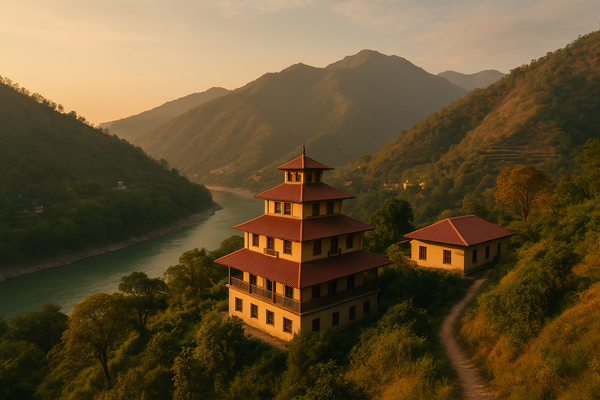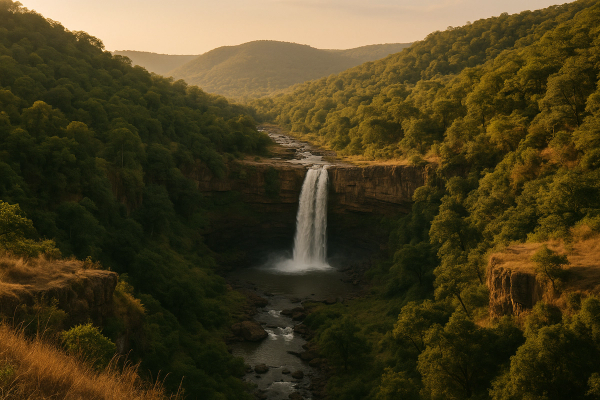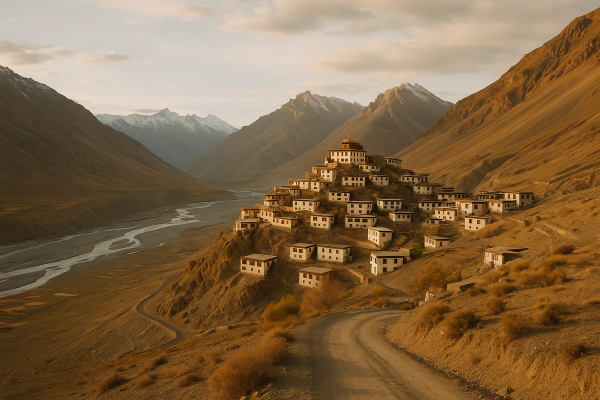Spiritual Tourism in Ayodhya 2025: My Honest-to-God Ram Mandir Guide#
Okay, so let's talk about Ayodhya. I just got back—spent four, no, five incredible days there, and honestly, my mind is still buzzing. I went for the spirituality, for the history, and of course, to see the Ram Mandir. And let me tell you, it's a LOT. In a good way! It’s not just a temple; it's the heartbeat of a city that's transforming before the world's eyes. I feel like I winged a lot of it, so I wanted to create the guide I wish I'd had. This is for anyone planning a trip in 2025, looking for that blend of divine vibes and real-talk travel tips. Forget the sterile guides; this is the real deal on spiritual tourism in Ayodhya.¶
Destination Overview: What's the Vibe in Ayodhya?#
Ayodhya is... intense. It's a city on the banks of the sacred Saryu River in Uttar Pradesh, and for millions, it's the birthplace of Lord Ram. [4] You feel that significance everywhere, from the constant, gentle chants of 'Jai Shree Ram' to the sheer number of pilgrims. It’s a city of ancient temples, winding lanes, and a palpable sense of devotion. [36] The energy is electric, especially now with the new Ram Mandir. But it's also a city grappling with rapid change. Expect a mix of ancient holiness and modern construction. It's a bit chaotic, deeply spiritual, and utterly fascinating.¶
When to Visit: Honestly, Avoid the Heat#
So, when should you go? Not gonna lie, the weather can make or break your trip. I learned that the hard way. Here’s a quick and dirty breakdown.¶
| Season | Months | Weather | Crowds | Vibe |
|---|---|---|---|---|
| Winter (The Best!) | October - March | Pleasant, cool (8°C to 25°C) | High (especially during festivals) | Perfect for sightseeing, festive energy. [5] |
| Summer | April - June | Brutally hot (can hit 42°C) | Lower (for good reason) | Honestly, I'd avoid it. The heat is draining. [3] |
| Monsoon | July - September | Humid, rainy, but green | Moderate | Fewer crowds, but travel can be disrupted. Good for a quieter, introspective trip. [5] |
My two cents: Aim for October to March. [3] The weather is a game-changer. I went in late February and it was perfect. Also, major festivals like Diwali (Deepotsav) and Ram Navami happen during this period, and the city just lights up. It's crowded, sure, but the experience is unforgettable. [9]
How to Get There & Get Around#
By Air: The New Airport is a Blessing#
Getting to Ayodhya is easier than ever. The new Maharishi Valmiki International Airport (AYJ) is a game-changer, with direct flights from major cities like Delhi, Mumbai, and Bangalore. [25] It's about 10 km from the city center. From the airport, a pre-paid taxi is your best bet; it cost me around ₹500-₹700. [10] An alternative is flying into Lucknow (LKO), about 135 km away, and then taking a 3-hour taxi or a bus. [25]¶
By Train: The Classic Indian Way#
Ayodhya has two main railway stations: Ayodhya Dham (AY) and Ayodhya Cantt (AYC). They're well-connected to the rest of India. [14] I took an overnight train and it was a great way to ease into the journey. Pro tip: book your tickets WEEKS, if not months, in advance, especially for festival dates. They sell out crazy fast. [14]¶
Getting Around: E-Rickshaws are Your Best Friend#
Once you're there, the city runs on e-rickshaws. They're everywhere and super convenient for navigating the narrow lanes. A short ride costs anywhere from ₹30 to ₹100. My advice? Settle the price BEFORE you get in. I got ripped off my first time, lol. For longer distances, you can book auto-rickshaws or taxis.¶
Where to Stay: From Dharamshalas to Hotels#
Accommodation in Ayodhya runs the gamut. You can find everything from simple guesthouses to newer, more comfortable hotels. Book in advance—I can't stress this enough. [9]¶
- Dharamshalas & Ashrams: For the most authentic and budget-friendly experience, this is it. Places like Birla Dharamshala and Jain Dharamshala are well-known and close to the main temples. [24] They offer basic, clean lodging and a spiritual atmosphere.
- Mid-Range Hotels & Homestays: There's a growing number of these. I stayed at a homestay called 'Ramam by Naavagat' which was about 700 meters from the Ram Mandir and it was great. [18] Look for options near the Ram Janmabhoomi or Naya Ghat area for convenience.
- Luxury Stays: High-end options are still emerging, but you can find more luxurious hotels and tent cities, like the Praveg Tent City Ayodhya, for a more pampered stay. [12]
Side note: Many dharamshalas are super close to the action. For instance, Shree Ram Janki Seva Trust is just over a kilometer from Hanuman Garhi and the Ram Mandir. [23] Perfect if you want to be immersed.
The Ultimate Ayodhya Guide: What to See & Do#
1. The Ram Janmabhoomi Mandir (The Main Event)#
Okay, this is why you're here. The temple is magnificent, built from pink sandstone with no iron or steel. [15] The sheer scale and devotion are humbling. Darshan (viewing the deity) is free but you have to plan it. The temple is generally open from 7:00 AM to 11:30 AM and 2:00 PM to 7:00 PM. [15] (Always check the latest timings on the official Shri Ram Janmbhoomi Teerth Kshetra website as they can change!). [17]¶
- Booking Darshan: As of now, online booking is highly recommended to manage crowds. You can do this through the official website. [17]
- What You Can't Bring: Phones, bags, belts, chargers... basically anything except your ID and cash/cards. There are free locker facilities available, but they get crowded. Travel light! [20]
- Crowd Tip: Go on a weekday, early in the morning. Seriously. The weekends are packed. The atmosphere right at opening is so serene and powerful. [27]
2. Hanuman Garhi: The Customary First Stop#
It's a local tradition to visit this 10th-century temple dedicated to Lord Hanuman before going to the Ram Mandir. [4] It's perched on a hill, and you have to climb 76 steps to get there. The belief is that Hanuman protects Ayodhya from his cave here. The energy is vibrant and it offers great views of the city. [4, 6]¶
3. Kanak Bhavan: The 'Golden House'#
Just a short walk from the Ram Mandir, this temple is stunning. It's believed to have been a palace gifted to Sita by Queen Kaikeyi. [8] The idols of Ram and Sita here are beautifully adorned. It's often called 'Sone-ka-Ghar' (House of Gold) and is a relatively peaceful and beautiful spot to just sit and absorb the vibes. [6, 13]¶
4. Saryu River Ghats (Ram ki Paidi & Guptar Ghat)#
You absolutely cannot miss the evening aarti at the Saryu Ghats. Ram ki Paidi is a long stretch of steps where hundreds gather at sunset. The sight of all the lamps, the sound of the bells and chants... it's magical, pure and simple. Guptar Ghat is another important spot, believed to be where Lord Ram took 'Jal Samadhi' (left his earthly form by entering the river). It's quieter and very serene. [6, 36]¶
5. Lesser-Known Spots (My Personal Faves)#
- Nageshwarnath Temple: An ancient Shiva temple said to have been established by Lord Ram's son, Kush. It's a bit different from the other temples and has a powerful, ancient feel. [4]
- Dashrath Bhavan: This is believed to be the site of King Dashrath's original palace, where Ram and his brothers grew up. It’s more of a palace-like structure with a shrine inside. [4]
Ayodhya Food Guide: What to Eat & Where#
The food in Ayodhya is mostly vegetarian (Sattvic, meaning no onion or garlic in many places) and delicious. It's a street food paradise!¶
Must-Try Local Dishes#
- Kachori Sabzi: The quintessential Ayodhya breakfast. Crispy kachoris served with a spicy potato curry. New Saryu Sweets is a great place for this. [16, 21]
- Chaat: From Aloo Tikki to Papdi Chaat, the street stalls near Hanuman Garhi and Ram Ki Paidi are where it's at. Mahaveer Tikkiya is a local legend. [16, 22]
- Lassi & Thandai: Perfect for cooling down. You’ll find stalls selling these creamy, refreshing drinks all over the city. [21]
- Peda & Rabri: Don't leave without trying the local sweets. Pedas are often given as prasad, and the rabri (thickened sweet milk) is just divine. [21, 31]
Foodie Tip: Many restaurants like Ram Rasoi Bhojanalaya serve a full 'Sattvic Thali'—a platter with multiple dishes. It's a great way to sample a lot of local flavors in one go! [21]
Practical Travel Tips for Ayodhya 2025#
Realistic Budget Breakdown#
| Expense | Budget Option | Mid-Range |
|---|---|---|
| Accommodation | ₹500 - ₹1500 / night (Dharamshala/Guesthouse) | ₹2000 - ₹5000 / night (Hotel) |
| Meals | ₹300 - ₹600 / day (Street food/local eateries) | ₹800 - ₹1500 / day (Restaurants) |
| Local Transport | ₹100 - ₹200 / day (E-rickshaws) | ₹300 - ₹500 / day |
| Daily Total (Approx.) | ₹900 - ₹2300 | ₹3100 - ₹7000 |
Packing & Cultural Etiquette#
- Dress Code: Be respectful. For temples, this means covering your shoulders and knees. Men can wear kurtas or full pants, and women can wear sarees or salwar kameez. Modesty is key. [27, 39]
- Footwear: You'll be taking your shoes off a lot. Wear something comfortable and easy to slip on and off, like sandals or loafers. [38]
- Safety: Ayodhya is generally safe, especially in the main pilgrim areas. [7] But like anywhere, be aware of your surroundings, especially in crowds. Keep your valuables secure.
- Language: Hindi is the main language. Learning a few phrases like 'Namaste' (hello), 'Dhanyavaad' (thank you), and 'Kitne ka hai?' (How much is it?) goes a long way.
A Suggested 3-Day Itinerary#
Here’s a rough plan to cover the essentials without rushing too much.¶
- Day 1: Arrival & Spiritual Immersion. Arrive, check into your hotel. In the afternoon, visit Hanuman Garhi, followed by the Ram Mandir for an evening darshan. End your day at Ram ki Paidi for the magical Saryu Aarti.
- Day 2: Temples & Culture. Morning visit to Kanak Bhavan. Explore the surrounding area, including Dashrath Bhavan and Nageshwarnath Temple. Spend the afternoon wandering the markets and trying street food. Maybe a peaceful evening visit to Guptar Ghat.
- Day 3: Reflection & Departure. A final early morning visit to a favorite spot or a temple you missed. Enjoy a leisurely breakfast and then head to the airport or railway station.
Responsible Tourism: Be a Good Pilgrim#
Ayodhya is handling a massive influx of tourists. As visitors, we have a role to play. [34]¶
- Reduce Waste: Carry a reusable water bottle. Avoid single-use plastics. The city is working on waste management, but every little bit helps. [42]
- Respect the Sanctity: Remember this is a holy city. Be mindful of your actions, speak softly in temples, and don't photograph people praying without permission. [39]
- Support Locals: Eat at local eateries, buy handicrafts from small shops, and use local transport. This ensures your money benefits the community directly. [34]
Final Thoughts: It's More Than a Trip#
My trip to Ayodhya was... profound. I went expecting to see a temple, but I found the soul of a city that is ancient yet brand new. The feeling of standing at the Saryu Ghat as thousands of lamps float on the water is something I'll never forget. It's a journey that's more than just sightseeing; it's a deep dive into faith, history, and a culture that is incredibly alive. If you're considering spiritual tourism in Ayodhya for 2025, my advice is simple: go with an open heart, a good pair of walking shoes, and be ready to be moved.¶
Have you been to Ayodhya? Share your favorite spot in the comments! Planning a trip? Save this guide for later or check out our other travel resources at (https://allblogs.in)¶














